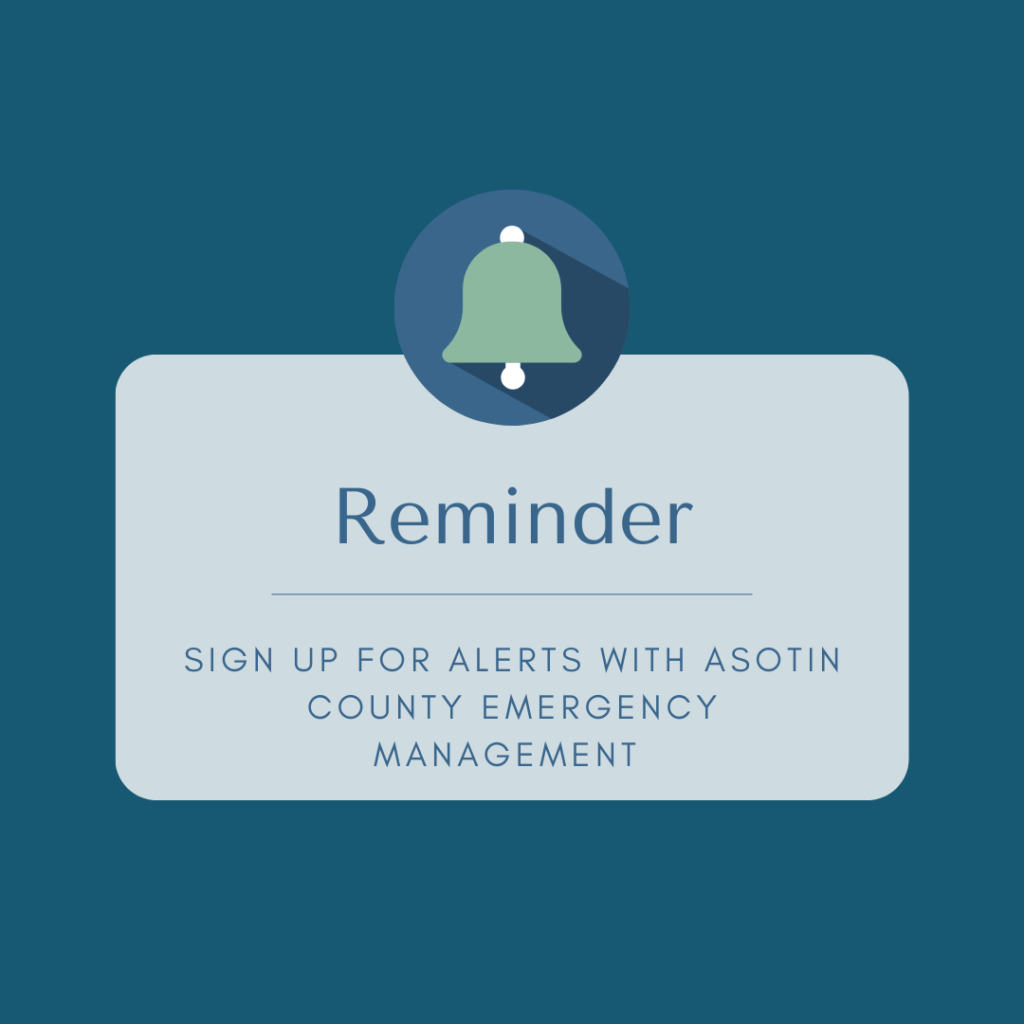
You never know when a disaster will happen and having an emergency kit can be very helpful. It doesn’t have to take a lot of time or money to start your kit. Even just having some extra food and water on hand can go a long way during an emergency.

Are you signed up for Asotin County emergency alerts? Registration is free and quick! https://tinyurl.com/459sxycb
Make a Kit
Check out this list of items to include in your emergency kit.
Don’t forget about your pets! You can find a list of emergency kit items for your pets here.
Remember to check expiration dates and rotate food and water as necessary.
Consider making smaller kits to keep at work or in the car. Check out Ready.gov for tips to plan ahead. Consider the unique needs of your family when planning, including children, pets, or those with disabilities.
Every family is unique. You may have emergency needs not included in this list. Also, remember to update your kit according to changing needs of your family.
Be sure it’s ready to use. In a disaster situation, you may need to get your emergency supply kit quickly, whether you are sheltering at home or evacuating.
- Once you have gathered your supplies, pack the items in easy-to-carry containers.
- Clearly label the containers and store them where you can reach them easily.
- Remember that certain items, like medications and paper documents, need to be kept in waterproof containers.
Family Disaster Plan
You and your loved ones may not be together when a disaster hits. Make a plan for how you will connect to each other. Start by taking the following steps:
- Complete a contact card for each family member. Everyone should keep these cards with them at all times.
- Choose an emergency contact. Memorize the phone number if you can. A friend or relative who lives out of town might be easier to reach in an emergency. During an emergency, family members can text or call this person to let them know that they are safe.
- Make sure all your family members know how to text. Make sure everyone knows how to turn on a cell phone, find the text messaging app, type a message, and send it to a contact.
- Know emergency telephone numbers. Keep them in your cell phone and post them near your home phones. Some good numbers to have are your emergency contact, the fire department, police station, and hospital near you
Make a Family Disaster Plan Before making your disaster plan, its important to know what types of emergencies are likely in your area and the best way to respond. For example, if tornadoes are common in your area, you will need to know what the warning signs are and where to take shelter. Check with your Local Red Cross chapter or Emergency Management Agency for more information.
- Find the safe spots in your home for each type of disaster. For example, during an earthquake you will need to “drop, cover, and hold on” under a sturdy desk or table. However, during a tornado, you would need to seek shelter in a lower level room without windows. Learn more about different types of disasters.
- Choose multiple meeting places. Different disasters may require you to go to different places. Make sure you choose a meeting place in your neighborhood, a meeting place just outside your neighborhood, and a meeting place out of town.
- Determine the best escape routes from your home. Find two ways to get out of each room.
- PRACTICE. Review these plans with all members of your family. Practice your disaster plans by running drills with the whole family.
- Don’t forget pets! Think about what you would do with your pets, because they may not be allowed in emergency shelters. For more information, check out Preparing Your Pet for Emergencies.
Get your kids ready
- Teach children how and when to call 911 for help.
- Quiz your kids on the plan to make sure they remember what to do.
- Include your kids in planning and drills.
Ready Wrigley can help your kids be ready for many kinds of emergencies! Take these additional steps to be prepared
Check and replace your supplies throughout the year, as needed.
- Make an emergency kit, and be sure to check and replace your supplies throughout the year, as needed.
- Stay informed; find the best ways to get disaster information from local authorities.
- Make sure that you have enough insurance coverage for your property. Specifically, think about the types of disasters that are common in your area.
- Learn how and when to turn off the water, gas, and electricity at the main shut-off locations.
- Show each family member how to use the fire extinguisher, and show them where it’s kept.